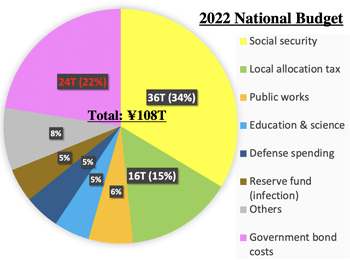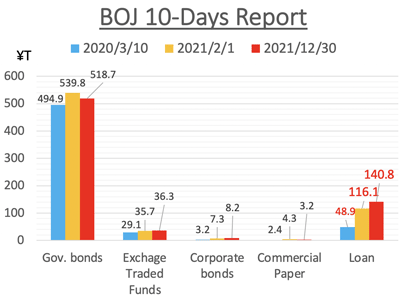>Top 2. Risks of the Japanese economy in the first half of 2022 - Minefields:
- Many Japanese corporate excecutives are still optimistic about the 2022 economic outlook of Japan. It should be important to look at risks straightly and how to draw a bright secenario considering such risk factors.
- Minefielsd - risk factors:
- Jan-Feb: Covid-19 6th wave of pandemic as well as progress of stagflation.
- Mar: the annual spring labor wage negotiation will be unseccessfull.
- Mar-Jun: Drastic reduce of monetary easing, and increase of interest rate.
→Widening of interest rate difference betwen US and Japan.
→Further depreciation of yen, causing import inflation
- Apr: The effect of redcuing mobile phone charges disapperas.
→acheved comsumer price index 2% up (due to unexpected macro ploicy)
→will reveal the collapse of monetary poliby of BOJ.
- Jun: Re-raise of interest rate of US Fed.
- Jul: Election of Japanese House of Councilors
- After the result of rise of comsumer's price:
- If BOJ raises the interest rate, then:
→Expansion of Government-bond costs
→Damage to the value of G-bonds held by BOJ
→may cause burst of the bubble,
→may cause fisacl andd financial paralysis
- If BOJ could not raise the interest rate, then:
→Widening interest rae differencee between US and Japan.
→may cause further depreciation of yen.
→may cause rsisin import prices.
→may cause advere impact on individuals and SMEs.
- If US Fed raises US interest rate:
→may cause falling in stock prices and reas estate prices
→may cause further progress of depreciation of yen.
→may cause burst of the bubble economy
→may cause crisis of SMEs dependent on the borrowing money.
- <Fig.> 2022 Japanese national budget:
- If the interest rate rises by 1%, G-bond expense will increase by 10 trillion yen, equivalent to the double of the present defense budget.
- When the nteres rate rises, the price of G-bond falls down.
→may cause depreciation of the value of G-bond held by BOJ (now 400-600 T¥)
→may cause averse impact on the equity capital of BOJ (now 9 T¥)
→may cause deline of the creditworthiness of BOJ.
→may cause deterioration of Yen note (issued by BOJ)
- If the intgerfestg rate raise, the burst of bubble economy occurs.
→may cause scrifice sales of due to overburden of the interst rate.
→may cause economic stagnation.
→may reveal the failuire of Abenomics, accumulating G-bond issue up to 1000 T¥.
- >Top BOJ has promoted so-called zero-zero loan for SMEs. (with zero interest and zero secured loan); this policy had been forbidden as the central bank (as releaf measures agains corona virus)
→Tokyo Shoko Research reports that Japanese SMEs shows with decreased sales and increased profits, being more dependent on loans.
→may cause further increase of voluntary retirement, and reduction of labor costs, and fixed costs for survival of SMEs.
→may cause increase of the monthly sales to borrowing ratio.
→may cause increase of bankruptcy due to risins cost of the raw materials.
→may cause almost 60-70% of SMEs are in deficit.
- Stupid policy of Kishda Cabint's supplementary budget:
- →Cast handout (100K yen) for younger generations
→Subdidy for gasonlice price
→Further
reduction of corporate tax when increased the salary payment.
- >Top Supporting Japanese economy by huge G-bond issuance through the negative interest rate mechanism.
- Negative interest rate mechanism: fees ae charged for balance of the privatre banks' current account in BOJ
- G-bond (10-year bond) are alittle plus interest, but shorter G-bonds are minus interest (almost -0.1%)
- The burden of BOJ to cover the negaive interest rate is about 2T¥, and the cumulative total is about 12.3 T¥.
- In reality, private banks do not bear the negative interst rates; the interest rate si the total of the basic balance rare 0.1% + the macroscopical additional balance 0%.
- Actually, the mechanism when G-bond interest rate become negative is such that BOJ pays 110 valued G-bond with a par value of 100 at maturity date; thus meaing 10 value loss at the maturity date.
→On the other hand, J-Government earns 110 income fro selling the G-bond with a face value of 100.
→If and when the negative ingterest rate become to the positive it will be a double burden of the sume of decreasing income + increase of interest rate.
→MOF already estimated such loss will be 0.8 T¥ in the first year, 3 T ¥ in the second, 3.8 T¥ in the third, then will be 10 T¥ in 5-6 years; this is the 'Debt Trap'.
- Since the nominal value is less than the book value by the negative interest, foregin investors and BOJ buy the G-bonds; Japanese government earns income without paying interest such as J-Gove earns 110 value from G-bonds having the nominal valu of 100.
- However, when the interest rates rises, the G-bond costs will expand.
- Fund-raising of BOJ:
- >Top BOJ prepared funds for the second stage supplementary budget in 2020: 212.e T¥ by G-bonds:
- 39% by short-term G-bond (3 months, negative rate): 82.5 T¥
- 29% by medium-term G-bond: 61.2 T¥
- about 70% of short-term G-bonds are bought by foreign investors.
- The Basis Swap trading method makes money by the interest rate difference between US TB and Japanese negative interest rate.
- BOB's Purchase of G-bonds (2021/12/20):
- Long-term G-bonds: 505.5 T¥
- Nominal value of G-bonds: 493.1 T¥
- Book value - Nominal value: 12.4 T¥
→BOJ bears the burden of G-bond cost.
- If the global supply chain is fragmented due to the corona pandemic, exports cannot increse even if the yen is depreciated, wile the imports will increase.
- When the consumer price index reached 2%:
- What was the inflation target of 2% aimed within two years from Apr. 2013?
- How the reflationists will lift monetary easing policy once they achieve it? Or, do they admit that it was just a fund-rasing to cover the fince deficit?
- What about the MMT suporters who said to raise taax when the inflation attains about 2%?
- or what about the policies for; 1)the job gurarantte program, 2) economic improvement including disparity correctioon?
- or do they abandon the Keynesian anti-circulation policty?
- What would be the possible bankruptcy of the control tower of macro policy?
- Historical fiscal spending without tax increase:
- Money recoinage: eventually caused destruction of the Roman Empire.
- Credit money (particularly banknotes) is secured by the credit ot the government and the central bank.
- subject to hyperinflation rarely occures.
- only exceptions; Germany and Japan after the war, Russia, Turkey, etc.
- However, there wold be medium crisis happening senario:
- Expansion of G-bond cost, causing financial crisis (Debt trap).
- Currenct depreciation, causing import inflation.
- Monetary easing, causing bubble and its collapse.
|
2.
2022年前半の日本経済のリスク-地雷原:
- 多くの日本の経営者は、2022の景気見通しをまだ楽観視
- 本来はリスクをどう見極めて明るいシナリオを描くかが重要
- 地雷原:
- 1-2月:物価高騰
- 1-2月:コロナ第6波感染拡大とスタグフレーション
- 3月春闘不発、賃上へ法人財減税も不発
- 3-6月頃金融緩和大幅縮小または金利引上げ
→日米金利差拡大→円安→輸入インフレ
- 4月: 携帯料金値下げ効果の消滅
→物価目標2%UP達成 (マクロ政策の想定外)
→日銀の政策破綻の表面化
- 6月 米国FRBは再び金利引上げ
- 7月 参議院選挙
- 物価高騰の結果:
- 金利引上げ
→国債費膨張、日銀保有国債の価値毀損、バブル崩壊
→財政金融の麻痺
- 日本の金利上げられない」
→日米金利差の拡大→さらなる円安
→輸入物価の上昇→個人・中小企業への打撃
- 米国金利上昇
→株価・不動産価格下落 (バブル崩壊)
→円安休止?
→バブル崩壊で借入依存の中小企業の危機
- 2022 国家予算:

- 金利1%UPすると国債費10兆円増加=防衛費の2倍
- 金利UPすると国債価格下落
→日銀保有の国債(400-600兆円)の減価
→日銀の自己資本9兆円割れ→日銀の信用力低下
→日銀券の信用低下
- 金利UPするとバブル崩壊が起こる
→金利負担増で投げ売り→経済停滞
→アベノミクスによおる1000兆円国債発行のツケ
- 一方で、世界の中央銀行はインフレ抑制のために金利UPする。
→日米金利差の拡大→さらなる円安→輸入インフレ
- 日銀による中小企業向けゼロゼロ融資(無利子無担保)
中央銀行としては禁じ手 (コロナ対策)
→140兆円 (前年比+90兆円)
- 減収増益と借金依存の中小企業 (東京商工リサーチ)
→希望退職、人件費と固定費の圧縮
→借入金月商倍率上昇
→原材料上昇で倒産の危機
→赤字企業は60-70%
- 岸田内閣の補正予算は愚策:
→10万円給付、ガソリン補助金、法人税減税等
- マイナス金利の仕組みによる国債発行でようやく経済をもたせている:
- マイナス金利の仕組み: 当座預金に手数料をとる
- 10年債はちょっと+だがそれ以外はほぼ-0.1%金利
- 日銀の負担は約2兆円/年で、累積12.3兆円
- 実際には民間銀行はマイナス金利を負担していない
- 基礎残高0.1%+マクロ加算残高 0%
- 実際には国債をマイナス金利にする。日銀は満期で額面100の国債を110で支払う方式。満期になると-10。
→政府は、額面100の国債販売で110の収入を得る。
→マイナス金利をプラス金利にすると途端に
収入減+金利増の二重負担となる。
→財務省試算では、1年目0.8兆、2年目3兆→3年目3.8兆→5〜6年で10兆円増→財政破綻 (Debt trap)
- 額面価格<帳簿価格なので、外国投資家や日銀が国債を買取る→政府は利払いせずに収入→政府は額面100の国債で110の収入が得られる。
- 金利を上げると一層国債費が膨張
- 日銀の資金調達
- 2020年度の2次補正段階: 212.3兆円の国債
- 39%: 短期債(3ヶ月もの; -金利) 82.5兆円
- 29%: 中期債 61.2兆円
- 短期債の約70%は外国人投資家が購入
- ベーシス・スワップ (Basis Swap)という取引手法
- 日銀による国債購入: (2021/12/20)
- 長期国債: 505.5兆円
- 国債の額面価格: 493.1兆円
- 帳簿価格ー額面時価: 12.4兆円
- 政府の国債費負担を日銀が肩代わり
- サプライチェーンがグローバル化しているので、コロナ禍で寸断化されると円安でも輸出増ができないばかり、輸入増に拍車かかる。
- 消費者物価上昇率が2%に到達すると
- 2013/4の2年で2%の物価上昇目標を掲げたことは?
→リフレ派は、達成したら金融緩和を解除?
→単なる財政赤字のFinanceだったと認めるのか?
- MMT派でも2%位になった(大企業)増税するはず
→Jobs guarantee program (低所得者雇用プログラム)
→景気好転→格差是正→物価UP→増税
→ケインジアン的反循環政策を放棄する?
- マクロ政策の司令塔の破綻?
- 増税なしの財政支出:
- 貨幣改鋳→ローマ帝国の滅亡
- 信用貨幣(紙幣)は政府・中央銀行の信用が担保
→ハイパーインフレは滅多に起きない
→ドイツ、戦後の円、ロシア、トルコなど
- 中間的には危機発現シナリオがある。
→国債費膨張と財政危機 (Debt trap)
→通貨安→輸入インフレ
→金融緩和→バブルとその崩壊
|

